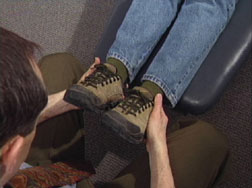 History and Presenting Symptoms
History and Presenting Symptoms
A 42 year-old male presents with recurring episodes of moderate pain in his low back and right hip. He denies injuring the region and cannot identify any precipitating activities or events. On a Visual Analog Scale, he rates his low back pain as varying from 25mm to 60mm, while the right hip pain is usually around 30mm. He takes over-the-counter NSAID’s when his back pain interferes with his daily activities, and that usually provides sufficient relief. He works as a car salesman and a baseball referee and is seeking non-drug treatment.
Exam Findings
Vitals. This male patient weighs 170 lbs which, at 5’11’’, results in a BMI of 24; he is not overweight. He is a non-smoker, his blood pressure is 124/84 mmHg, and his pulse rate is 80 bpm. These findings are within the normal range.
Posture and gait. Standing postural evaluation finds a lower iliac crest on the left, and a low left greater trochanter. The right shoulder is noticeably lower than the left, with no history of fracture or surgery. His lower extremities are symmetrical, with no significant calcaneal eversion, foot flare or low medial arch.
Chiropractic evaluation. Motion palpation identifies functional limitations in left lateral flexion and ipsilateral rotation at the L3/L4 and L4/L5 levels, with moderate tenderness and loss of end range mobility. Hip ranges of motion are full and pain-free. All provocative orthopedic and neurological tests are negative for nerve root impingement and/or disc involvement.
Imaging
AP and lateral lumbopelvic X-rays in the upright, standing position are taken while weight bearing. The heels are aligned directly under the femur heads, and both knees are extended. A discrepancy in femur head heights is seen, with a measured difference of 7mm (left side lower). A moderate lumbar curvature (6°) is noted, convex to the left side, and both the sacral base and the iliac crest are lower on the left side. The sacral base angle and measured lumbar lordosis are within normal limits.
Clinical Impression
Moderate anatomical leg length discrepancy (left short leg), with associated pelvic tilt and lumbar curvature. There is an accompanying history of recurrent mechanical low back pain and right hip pain.
Treatment Plan
Adjustments. Specific, corrective adjustments for the lower lumbar region were provided as needed, with good response.
Stabilization. Custom-made stabilizing orthotics were supplied, and a permanent 5 mm heel lift was added to the left side. These were introduced after the first week of regular adjustments.
Rehabilitation. He was instructed in a daily core strengthening program (the “easy eight” exercises), to be done at home using elastic exercise tubing. His exercise log was reviewed at each visit to ensure adherence to the exercise recommendations.
Response to Care
This patient responded rapidly to his spinal and pelvic adjustments. He reported no difficulty in wearing the orthotics, and no problems with the left heel lift. He brought his exercise log with him to every visit, which documented his regular performance of the home exercises. After three weeks of adjustments (10 visits) and daily home exercises, including wearing the orthotics with a heel lift, he successfully completed his re-examination and was released to a self-directed maintenance program. He has been seen occasionally for wellness adjustments, and he reports that he now feels “unbalanced” when he is not wearing his orthotics.
Discussion
With no history of injury to his leg, hip, or pelvis, this patient apparently has an anatomical short leg due to growth asymmetry. This condition is not rare, and is an often-overlooked cause of “mechanical” low back pain. Spinal adjustments and core strengthening exercises provided relief and improved function, but the underlying structural leg length inequality had to be addressed. Over time, this amount of discrepancy was bound to cause low back discomfort and, eventually, degenerative changes in the spine and the hip joint of the longer leg. In most cases, a permanent heel lift is best supplied with custom-made stabilizing orthotics, in order to ensure good foot biomechanics.
Dr. John J. Danchik is the seventh inductee to the American Chiropractic Association Sports Hall of Fame. He is the current chairperson of the United States Olympic Committee’s Chiropractic Selection Program. He lectures extensively in the United States and abroad on current trends in sports chiropractic and rehabilitation. Dr. Danchik is an associate editor of the Journal of the Neuromusculoskeletal System. He has been in private practice in Massachusetts for 29 years. He can be reached by e-mail at [email protected].
